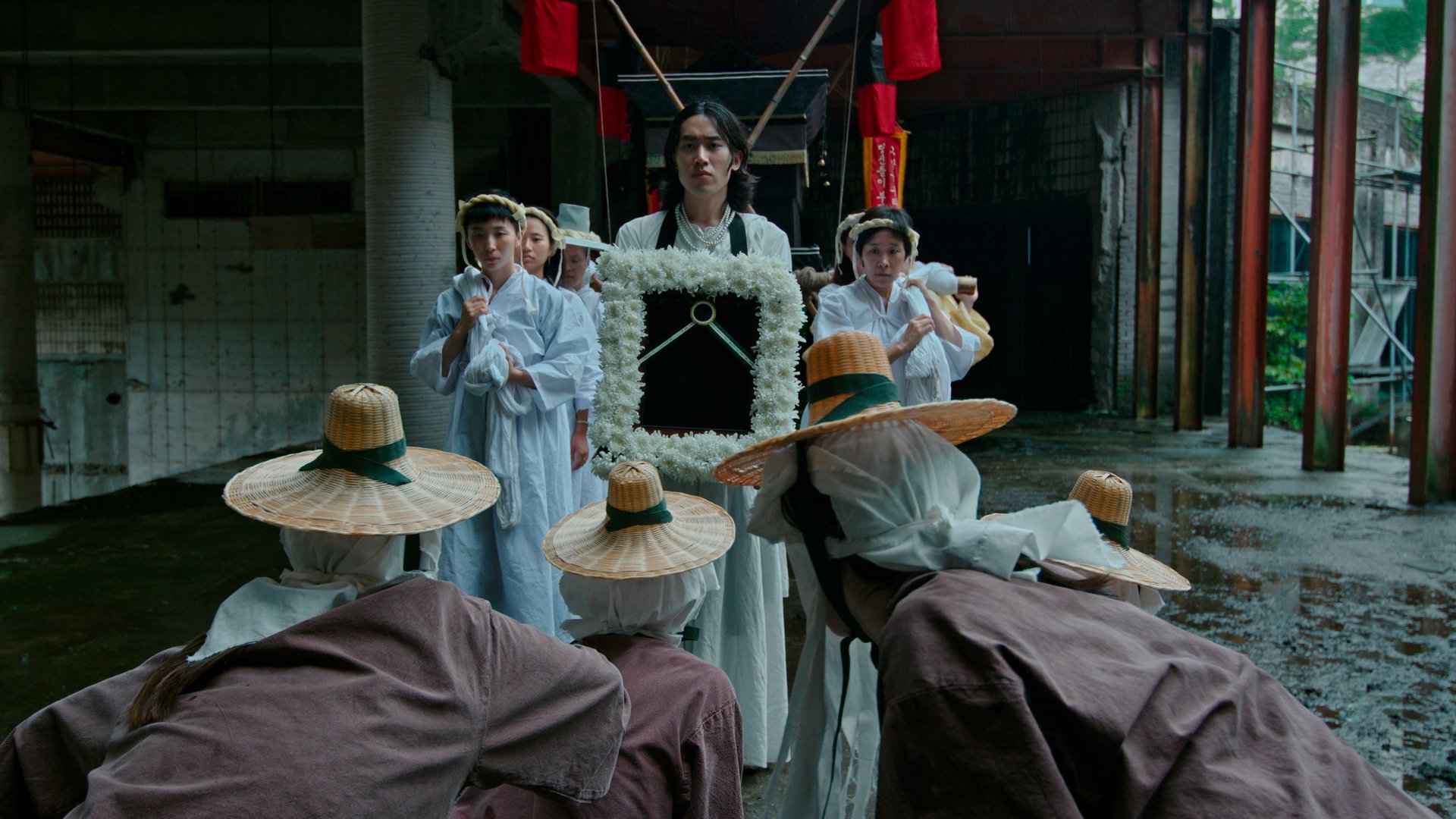JANE JIN KAISEN
Screening • Burial of this Order
22–24 September • 14:00 - 18:00 • Techne Sphere Leipzig • Free admission

Courtesy by the artist
Jane Jin Kaisen (born 1980 in Jeju Island, lives in Copenhagen) is a visual artist, filmmaker, and Professor of the School of Media Arts, The Royal Danish Academy of Fine Arts. Spanning the mediums of video installation, narrative experimental film, photographic installation, performance, and text, Kaisen’s artistic practice is informed by extensive interdisciplinary research and engagement with diverse communities. She is known for her visually striking, multilayered, performative, poetic, and multi-voiced feminist works through which past and present are brought into relation. Engaging topics such as memory, migration, borders, and translation, she activates the field where lived experience and embodied knowledge intersect with larger political histories.
Through multi-year projects and collaborations, she has engaged topics such as transnational adoption, the Korean War and division, the Jeju April Third Massacre, and Cold War legacies. Another recurring focus revolves around nature and island spaces, cosmologies, feminist re-framings of myths, and engagement with ritual and spiritual practices. Working from the thresholds of mediums and forms, disciplines and sensibilities, her works negotiate and mediate the means of representation, resistance, and recognition, thus contouring alternative genealogies and sites of collective emergence.
Kaisen is a recipient of the New Carlsberg Foundation Artist Grant (2023) and a 3-year work grant from the Danish Arts Foundation (2022). She represented Korea at the 58th Venice Biennale with the film installation Community of Parting (2019) in the exhibition History Has Failed Us, but No Matter curated by Hyunjin Kim. She was awarded “Exhibition of the Year 2020” by AICA - International Association of Art Critics, Denmark for the exhibition Community of Parting at Kunsthal Charlottenborg. Kaisen has participated in the biennials of Liverpool, Gwangju, Anren, Jeju, among others. Recent solo exhibitions include Jane Jin Kaisen: Braiding and Mending at The Image Centre (2023), Of Specters or Returns at Le Bicolore (2023), Currents at Fotografisk Center (2023) Parallax Conjunctures at Museum of Contemporary Art Detroit (2021), Community of Parting at Art Sonje Center (2021) and Kunsthal Charlottenborg (2020). Other recent exhibitions and screenings: Dislocation Blues: Jane Jin Kaisen, Tate Modern (2023), Ceremony (Burial of an Undead World), Haus der Kulturen der Welt (2022), Checkpoint: Border view from Korea, Kunstmuseum Wolfsburg (2022), Unmoored Adrift Ashore, Or Gallery Vancouver (2022).
She holds a PhD in artistic research from the University of Copenhagen, Department of Art and Cultural Studies, an MFA in Interdisciplinary Studio Art from the University of California Los Angeles, an MA in Art Theory and Media Art from The Royal Danish Academy of Fine Arts, and she participated in the Whitney Museum of American Art Independent Study Program.
Screening • Burial of this Order
21–24 September • 14:00 - 18:00 • Techne Sphere Leipzig • Free admission
A group of people come together to enact a burial ritual in an abandoned tourist resort in Jeju Island with the purpose of undoing an unliveable world order built upon forces of hierarchy, division, and destruction.
Dressed in funerary garments, the gathering of anti-military activists, environmentalists, social justice advocates, queer, trans, diasporic, and nonconforming musicians, artists, poets walk in procession carrying a funerary casket. It soon becomes apparent that it is not a conventional Confucian burial. Age and gender roles are undermined, the casket structure is draped in dark fabric and military camouflage, and the memorial portrait is replaced with a black mirror.
Actualized at the intersection of ritual ceremony, political protest, and carnivalesque performativity, the procession marches through the halls of the decaying resort that withstands as a ruinous infrastructure of capitalist modernity. Time and events start to unsettle: Dokkaebi deities surge through the building, torrential rain and wind gush through its hollow crevices, and in an instance of revolutionary fervor, the group refuses to provide a proper burial. Instead, they overthrow and dismantle the scaffolding of this order, and in the ritual transformation, other stories begin to take form.
Directed by: Jane Jin Kaisen / Produced by: Incisions / Line Producer: Soyoung Kwon
Script: Jane Jin Kaisen, Anselm Franke / Director of Photography: Daniel Zox / Gimbal Photography: Guston Sondin-Kung / Art Director: Abhijan Toto / Edited by: Jane Jin Kaisen / Composer & Sound mix: Udo Lee / Featuring: "4 + 3 = 1 RadioBook 5" recorded and produced by bela / Performers: Black Mirror Bearer: bela / Mourners: d. yaejin bang, Boram Hong, Okgwa, Mijounga, Jina Bak, bandi / Casket Bearers: Gyeol Ko, Dan Kim, Jeanjacques, Seorim Kim, Soyoon, e-sang, James Gui, Sookie Kwak / Drummer: Oksusu / Negation Chanter: Choi Sung-hee / DoKaebi Gods: Holly Yu, Jiyoung Wi, Jeijin Kim, Sungeun Lee / Banner Bearers: Maja Lee Langvad, Sollee Kim, Jungle, Daeyoung Ko
Assistant Director: Grace Sungeun Kim / Story Visualization: Daniel Zox / Conceptual Consultancy: Anselm Franke / Assistant Camera: Hyeongyong Kim / Assistant Producer: Kahee Jeong / Translation of Script: Jungweon Mok / Colorist: Edoardo Rebecchi / Behind the Scenes Photography: Theo Bu Sondin-Kaisen / Carpenters: Seokhee Han, Sungwon Cho / Props Assistants: Jeijin Kim, Sungeun Lee / Graphics: Jung, Jonas Handskemager / Runners: Nata, Kyungho Woo, Sangdo Woo, Yaeem Woo, Yaelin Woo
Bus Driver: Donghoon Han / With special thanks: Hyekyoung Ahn, Soonshil Suh, Youngmee Song, Maro, Nanda, Illboo Gang, Changwoo Kim, Heesuk Kim, Jaehyun Kim, Kyunghee Sung, Soosan, Seongnae Kim, Minsook Kim, Jonghyo Won, Dongjin Jang, Stina Hasse Jørgensen, Pujita Guha, The International Center for Knowledge in the Arts, Jeju Contents Agency, Borisol Pension, Holz Aewol / With support from: The Danish Artistic Research Funding Programme, Ministry of Culture, Haus der Kulturen der Welt, Berlin, The Danish Arts Foundation
FUNDERS

COLLABORATIONS


SOCIAL MEDIA
Facebook
Instagram
CONTACT
Email
Designed by Mote Studio
Last Updated: August 17, 2023